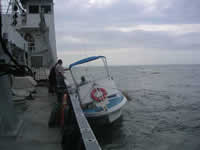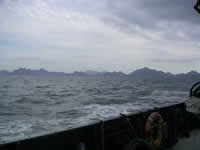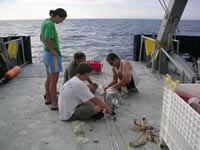


|
The Project Part 1: Part 2: Part 3:
|
28 July, 2005
|
 The refrigeration repair guys head back to Guaymas  The rugged coast near Guaymas, in the state of Sonora  Preparing equipment for the next day’s experiments |
More from The Log from the Sea of Cortez
“. . . all things are one thing and that one is all things- plankton, a shimmering phosphorescence on the sea and the spinning planets and an expanding universe, all bound together by the elastic string of time. It is advisable to look from the tide pool to the stars and then back again to the tide pool again.”
The scientists on this trip are searching for very tiny organisms and the even tinier chemical reactions that these life forms generate. Searching for these minute processes enlarges the scientists’ (and ours if we care to learn) understanding of a vast and complex universe.
The scientists’ work began late Wednesday night and will continue until the early hours of Thursday morning. We are anchored above 2000 meters of water. Schools of squid and flying fish flit through the dark waters. Sometimes the flying fish miscalculate and land on deck gasping and writhing. If we see them in time, we throw them back into the roiling water. Heat lightening explodes in quick bursts over the Baja Peninsula.
The sampling has begun in earnest. But what exactly is sampling? The scientists are taking sea water from different depths and locations in the Gulf. This water is then run through filters to trap the microscopic critters that reside there. Some of the water is filtered for fertilizers (nutrients), while some of the experiments will analyze various characteristics of these microscopic organisms.
At 3:00 am, we head for the port of Guaymas on the Mexican mainland to pick up the scientists who will be collaborating with us. We also have an appointment with a refrigeration expert. Last evening the freezer and the refrigerator in the galley broke down. We formed a chain line and passed all the food out to another freezer on deck. Hopefully the problem can be easily remedied. The cooks are working in less than favorable conditions, but still managing to whip out three very tasty squares a day.
Math Problem: The lower bunk I sleep in measures 72 inches long, 35 inches wide, and 30 inches high.
- What is the area of the mattress?
- What is volume of the bunk?
- Convert the area and volume into the metric system.
- Is this a large space, or just about right?
Trivia Tidbit of the Day:
In 1943, Jacques-Yves Cousteau, a French naval officer, and Emile Gagnan, a French engineer, invented the aqualung. This device allowed divers to breathe air from canisters on their backs and to move freely underwater.
![]()
